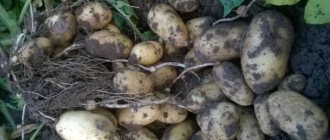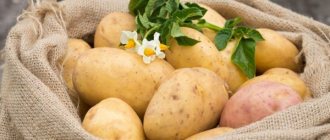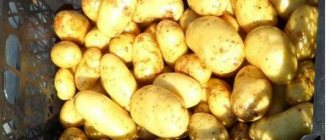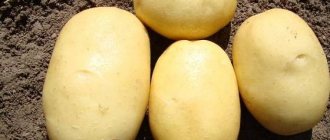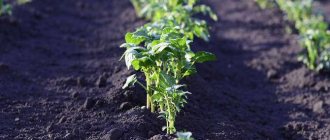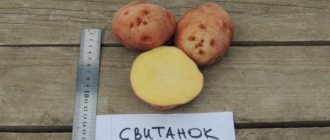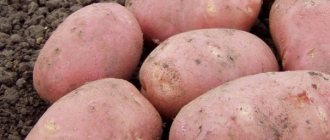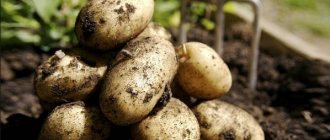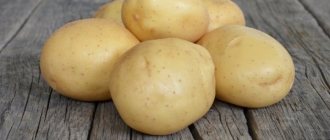Many people who grow potatoes increasingly prefer the productive and early ripening variety Bellarosa. And this is not in vain, because it has exceptional resistance to pests and diseases, is easy to grow and does not require any special conditions or care. To get a good harvest, you just need to know a few rules and secrets.
Description of the variety
One of the distinctive features of Bellarosa is that the crop looks healthy, and during the flowering period the crop also performs a decorative function on the site.
Escapes
Shoots of this variety appear evenly, their maximum height is 80 cm. The stems of Bellarosa are thick and strong, and the leaves are succulent with slightly wavy edges. During flowering, red-violet flowers appear on the bushes.
Fruit
When the plant fades, potato tubers begin to appear on the roots. Usually their number does not exceed 10 pieces under one bush. The fruits are most often all the same in size, their weight is approximately 200 grams. However, sometimes very large ones are found - about 800 g.
The potatoes are oval or slightly round, have a pink-red skin with a rough surface of medium thickness. The tubers have very small buds called eyes. The fruit itself under the skin is light yellow or cream. Another feature of Bellarosa is that the potatoes have a sweetish taste.
This variety is suitable for both cooking and frying: its starch content is 15%. During cooking, Bellarosa does not darken like other potato varieties.
Possible problems during cultivation
Gardeners often encounter a lack of flowering of the Bellarosa variety. Possible causes of the problem and solutions:
- Attacks of ladybugs, ground beetles. Dusting the bushes with wood ash, garlic or wormwood tincture will help. The stems are sprayed with Fitoferm solution.
- Growing vegetables in poor soils. The problem will be solved by the application of organic and mineral fertilizers.
- Diseases. The health of Bellarosa potatoes depends on proper care of the crop and timely treatment with chemicals.
- Excess nitrogen fertilizers in the soil. Potatoes rush upward, growing tops; there is no strength left for flowering and normal tuberization. It helps to add 200 g of wood ash under each bush and trim the tops by 50%.
- Weakened seed tubers. Such potatoes are especially demanding when it comes to feeding. When planting, add a handful of humus to each hole.
Another reason that cannot be influenced is temperature above 22 °C. The absence of flower stalks is genetically determined only in very early and mid-early varieties. Bellarosa potatoes should bloom. But according to the observations of experienced gardeners, unfriendly flowering of a crop or the absence of flowers on all bushes does not affect the amount of harvest and the size of tubers.
Another possible problem when growing Bellarosa potatoes is yellowing of the tops. This phenomenon can be observed during severe drought in July. A slowdown in metabolic processes leads to a lack of nutrients, yellowing of the leaves, and poses a threat to the future harvest. The situation is corrected by watering during flowering of the crop.
The leaves turn yellow when there is a deficiency of nitrogen, potassium, phosphorus in the soil, or when the bushes are damaged by pests and diseases.
Characteristics of the variety
The main characteristic features of the variety:
- Precocity. Literally 60 days after planting the potatoes, the crop is harvested. And you can dig up the tubers already at 40-45 days.
- In southern Russia, Bellarosa can be grown twice a year, and therefore harvested twice. At the beginning of July, the first fruits are harvested and the potatoes are immediately planted in the same place again, and the second harvest is harvested in early autumn.
- The harvest is large - 30 tons per hectare.
- Can grow on almost any type of soil.
- Bellarosa is resistant to dry weather. Even with a long absence of rain, potatoes form normally in dry soil.
- The harvest can be stored for a long time.
Advantages and disadvantages
The Bellarosa variety has many advantages and disadvantages over other potato varieties:
- High yield.
- Precocity.
- Long-term storage of crops. Typically, early varieties are not stored for a long period and quickly become unusable. This is another important advantage of Bellarosa. If you store the crop correctly, the losses will be absolutely insignificant.
- Easy to grow. Most often, potatoes are not watered at all; they only receive water when it rains.
- Resistance to diseases, including late blight. Bellarosa does not suffer from diseases such as black leg, rhizoctonia, and does not become covered with scab.
- Pleasant taste.
- Potatoes do not suffer from mechanical damage. This variety has a rather dense skin, so the tubers do not deteriorate when digging up the crop.
Despite the many advantages, this variety also has several disadvantages that you should be aware of when growing Bellarosa:
- The plant may suffer from pests: the Colorado potato beetle and wireworm. Therefore, it is necessary to carefully check potatoes for the presence of insects.
- Bellarosa is sensitive to lack of light. If there is not enough of it, the harvest will be small.
Video
The video shows the harvest of the Bellarosa variety:
Why are more and more gardeners choosing Bellarosa? Its tubers are tasty, it ripens quickly, and the plants are easy to care for (no additional watering is required). This variety is transported over long distances without much loss (82-99% retains its presentation). 93% keeping quality.
If there is a lot of rain during the season, then there is a high probability that the plant will get late blight. The root crops of this variety do not all grow close to the roots, but some grow further away, so when they are dug up, some can be damaged. The peel of the variety is bright red, which is why people call this potato “Cherry”. On the plus side, when owners carefully harvest and store the crop correctly, losses are only 6%.
How to prepare the plot and seed potatoes?
Preparations for planting potatoes must begin in the autumn. Fertilizers need to be added to the soil: compost or humus in a proportion of 7 kg per 1 sq. m plot. In the spring, the soil is dug up and fertilizers are added for growth, and the future harvest is also protected from insects. To do this, add ammonium nitrate, potassium or ammonium sulfate.
Experts advise growing potatoes in an area where cucumbers, herbs, cabbage or beets previously grew. The worst predecessors of potatoes are nightshade crops.
14 days before planting, place the selected tubers in wooden boxes or simply on the floor in the room, preferably in one layer, to prevent damage to the seed material. Before planting, potatoes should be stored in daylight and a temperature of +15 degrees so that sprouts appear on them.
Plant nutrition
Since Bellarosa is an early variety, it requires fertilizers high in magnesium for vigorous growth. Dolomite flour is suitable for this.
And also, as it grows, other fertilizers are added to the soil:
- Immediately after the first shoots appear, you can add chicken droppings or manure.
- Before the flowers appear, the soil should be fertilized with a solution of ash and potassium sulfate.
- During the period of active flowering, a fertilizer such as a mixture of superphosphate and mullein is suitable.
It is important to remember that fertilizing can only be done after abundant watering of the potatoes. Otherwise, the roots of the plant may be damaged.
Potato White Rose
Potatoes with the beautiful name “White Rose” are considered one of the best varieties. In some sources you can find the name “Bellarose” or “Bella Rosa”. The essence does not change from this. Potatoes are grown in huge quantities here in Russia and they know a lot about root vegetables. If rice is a valuable product for Asians, then potatoes and bread are valuable for Slavs. It is for this reason that any gardener in our country carefully chooses the variety to grow. Let's talk about what White Rose potatoes are. A description of the variety, photos, and reviews from summer residents will be presented below to create a complete picture.
Read also: Grafting fruit trees in spring: revealing all the secrets
Care
Caring for Bellarosa potatoes is simple: they need to be loosened and hilled.
Loosening helps the plant get more oxygen and water. During this procedure, it is also recommended to remove all weeds around the potato bushes using a hoe. Loosening should be done when the potato bushes are in the active growth phase and their height is no more than 15 centimeters.
Usually, during the entire growth phase of the bushes, loosening is carried out at least three times, but this depends on how often it rains. After all, during loosening, the crust on the soil that formed after the rain breaks down and prevents oxygen from reaching the roots of the plant. The first loosening should be done 7 days after planting Bellarosa. The second time is when the first shoots appear.
When the bushes have reached a height of 15 cm, instead of loosening it is necessary to start hilling. This procedure also helps the plant receive more air and moisture. When hilling, the soil is raked up to the bush so that the plant does not bend to the ground due to its height. Thus, around the bush you get a small hill of earth.
How to make a hiller so as not to loosen the soil manually - read here.
Recommendations for cultivation
It's no secret that the key to getting a rich harvest lies in caring for vegetable crops. So let's look at what kind of care Bellarosa will require.
Sowing
Considering that the Bellarosa variety is early, its planting should be planned for the end of April. But before this time, seed potatoes need to be germinated a little. To do this, 15–20 days before planting, the potato tubers must be provided with access to daylight and a temperature of about +15 degrees. It is very easy to determine the readiness of Bellarosa potatoes for planting: young shoots will grow from their eyes.
Some gardeners place potatoes in wooden boxes in several layers for germination. But with this placement, the bottom layer may not have enough ventilation and some tubers may spoil.
Advice! Therefore, it is better to simply lay the potatoes on the floor in one layer.
Before planting Bellarosa potatoes, you need to mark the bed and make holes. There should be at least 90 cm between adjacent rows, and up to 40 cm between holes. The holes should be made quite deep: from 8 to 10 cm.
When planting potatoes of this variety, any potassium-phosphorus fertilizer, for example Nitrophoska, should be placed at the bottom of each hole. Only after this can potatoes be placed in the hole, covered with soil and leveled.
Feeding
All early potato varieties require fertilizer containing magnesium. Especially if they are grown in soils with a predominant sand content. Most often, dolomite flour is used for this. In addition, it is recommended to apply fertilizers during important growth periods for plants:
- After the first shoots appear, it is recommended to use an infusion of manure or chicken droppings.
- Before flowering, potatoes should be fertilized with urea or a solution of potassium sulfate and ash.
- During flowering, the most optimal composition for feeding will be a mixture of mullein and superphosphate.
The application of any of these fertilizers is carried out only after good watering of the potato bushes or after rain. Fertilizing unprepared dry soil can burn the roots of plants.
Care
All care for potatoes of this variety consists mainly of two procedures: loosening and hilling.
Loosening is simply necessary for Bellarosa potatoes. It is thanks to loosening that the roots receive more moisture and oxygen. In addition, this procedure helps fight weeds, which especially like to settle near potato bushes. Despite all the benefits of this procedure, it is recommended to carry it out only during the period of active growth of bushes, when they have not yet reached a height of 15 cm.
After the Bellarosa bushes have grown above 15 cm, loosening the soil is replaced by hilling. Hilling, like loosening, helps improve soil throughput, making it easier for roots to access air and water. The essence of this procedure is to rake the earth closer to the potato bush so that as it continues to grow, it does not lean towards the ground. The photo below shows that a kind of mound is formed around the bush.
Experienced gardeners practice fan hilling of potatoes. You can learn more about this method from the video:
Many gardeners annually choose this particular potato variety. Below we will give reviews from those people who have already planted Bellarosa.
Why doesn't Bellarosa bloom?
It happens that this potato variety does not bloom, and garden owners worry whether there will be a normal harvest. Usually the absence of flowers indicates that the plant has a disease. But that's not always the case with Bellarosa. This variety is an early ripening variety, so they usually outstrip the appearance of insects and are also protected from diseases.
The lack of flowers may be because the bushes simply do not have time to bloom. If this is the reason, then this will not affect the harvest in any way.
Another reason may be that the bushes dropped their buds due to unsuitable air temperatures - above 22 degrees.
The appearance of insects can also prevent flowers from growing on potato bushes. The only pests that usually appear on Bellarosa are the potato ladybug and the ground beetle.
Reviews
Victoria, Tver : I want to note that Bellarosa amazed me with its productivity. The taste of potatoes is beyond praise. I've never tried potatoes like this before. I fry it - it doesn’t fall apart, it remains beautiful. Moreover, I didn’t do anything at all for productivity. I watered it occasionally, and sometimes I forgot. True, one day the Colorado potato beetle came to visit us. I barely got rid of him. But the variety is simply magnificent. I recommend everyone to plant it in their dacha - you will be satisfied.
Nikolay Stepanovich, Kursk region. : I was surprised by this variety. He is amazingly unpretentious and does not need close attention. As a forgetful gardener, this is perfect for me. I was even surprised when I began to harvest. I didn’t count exactly how much I collected, several buckets for sure. I transported the potatoes without any problems, although the road was bad. A couple of fruits were damaged, but no more. Used for cooking. It did not fall apart, remained very tasty and pleasant in color. I will definitely continue to grow it.
Ksenia Fik, Mariupol : If you want to try real homemade potatoes, then try Bellarosa. It always turns out delicious, no matter how you cook it. I watered this plant three times a season, and it still retained its properties. They say she is threatened by the Colorado potato beetle, but I have not encountered it. Just awful enough! The children also liked the potatoes: they made mashed potatoes from them. It turned out tender, satisfying and tasty. Incredible variety!
Diseases and pests
Bellarosa is highly resistant, so this variety is not afraid of any diseases inherent in other potato varieties. And any mechanical damage to the tubers quickly disappears, being covered with peel.
If there are pests on the plant, for example, the Colorado potato beetle, then the bushes should be treated with Fitoverm, Agravertin or Boverin. The drug Tabu also helps well against Colorado potato beetles, aphids and wireworms.
Harvesting
Since in warm regions it is possible to harvest twice a year, potatoes planted in May are harvested at the end of June, then planted again and harvested a second time in September.
That is, you can start harvesting two months after planting. A sign that the potatoes are ripe is yellowed tops. Experts advise cutting it at a level of 15 cm above the ground 7 days before digging up the potatoes. This will help the tubers to ripen further and the skin to become stronger so as not to be damaged when dug up.
After harvesting, the potatoes should be sorted out and diseased or damaged should be removed, and then dried in the air, but not in the sun, but in a well-ventilated place, for 6-7 days. After this, select seed potatoes for planting next season and store them in a suitable place.
The harvest can be stored for up to 8 months if you choose the right room. The air temperature should be +4 degrees, and the room should be ventilated.
You can see what the harvest of the Bellarosa potato variety looks like, and also learn more about how to harvest it, in the video clip:
There are only good reviews about Bellarosa. This is not surprising, because this variety has almost no disadvantages. It is easy to grow, it is unpretentious to the quality of the soil and the amount of moisture, and caring for such potatoes is very simple. You only need to follow a few rules to get a good harvest of tasty potatoes.
0
0
Copy link


